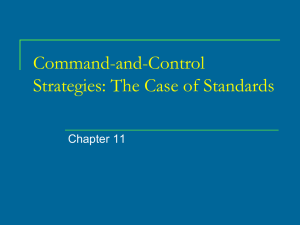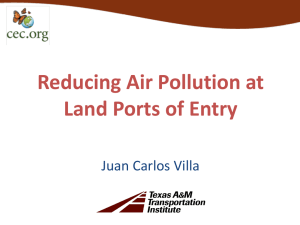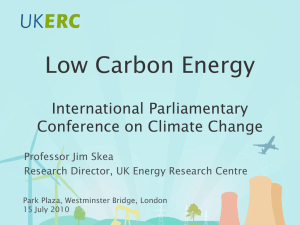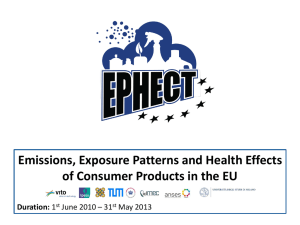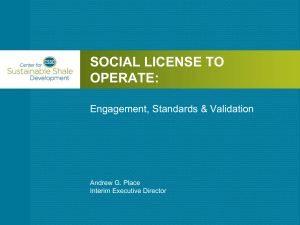Emission Charges and Subsidies
advertisement
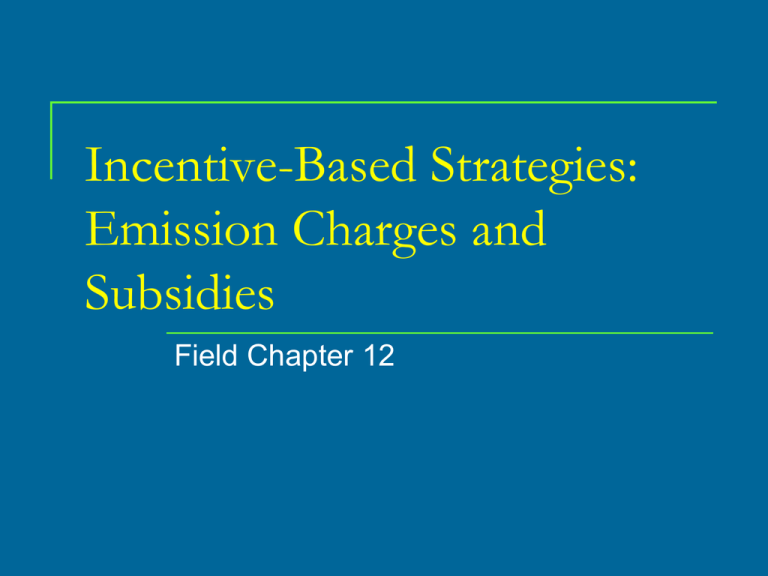
Incentive-Based Strategies: Emission Charges and Subsidies Field Chapter 12 Incentive Policies • There are basically two types of incentive policies: (1) charges and subsidies and (2) transferable discharge permits. • • Both require gov’t to get started Flexible firm responses to attain efficient pollution control. • • Under charges, firms respond however they wish to what is essentially a new price for using the services of the environment. The interactions among polluters or between polluters and other interested parties in the market for permits means the marginal abatement cost is equalized across firms. 2 Role of Economists Environmental economists have long favored the idea of incorporating incentive-based policies more thoroughly into environmental policies. Substantially improve the cost-effectiveness of environmental improvement. 3 Using the “Administered” Price System The most straightforward incentive-based approach to controlling emissions of a particular residual is to have a public agency offer a financial incentive to change those emissions. This can be done in two ways: by charging for each unit of emissions or by giving a subsidy for each unit of emissions that the source cuts back. 4 Emission Charges We deal first with emission charges, sometimes also called "emission taxes." In a charge system polluters are told: "You may discharge any amount of residuals you wish, but your emissions will be measured and you will be required to pay a certain charge for every unit (e.g., ton) of effluent you discharge. 5 Incentive to Conserve Under an emission charge firms must pay for the services of the environment— transportation, dilution, chemical decomposition, and so on. They will now have an incentive to conserve on their use of environmental services. Leaving polluters free to determine how best to reduce emissions means they can find the least-cost way of reducing emissions. 6 7 Tax vs. Performance Standard With the tax the firm's total outlay is $855. Had authorities relied on an emission standard of 4 tons/month, the firm's total outlay would be only the $375 of abatement costs. Polluting firms prefer standards to emission charges, but there are good reasons why society would often prefer charges over standards. 8 What Tax Rate? If we know the marginal damage function, set the charge so as to produce the efficient level of emissions, as in Figure 12-2. At a charge rate of t*, emissions are e*, and marginal damages equal marginal abatement costs. The firm's total costs of emission control are divided into two types: total abatement costs of e and total tax payments of (a + b + c + d). 9 10 Costs or Transfers? To the firm both abatement costs and taxes are real costs. For society the tax payments are different from the abatement costs. Abatement costs consume real resources, and are, therefore, social opportunity costs. Emission charges are transfer payments. 11 Emission Charges Exceed Damages The reduction of emissions from e0 to e* has eliminated damages of (e + f). Remaining damages are (b + d), an amount less than the firm pays in taxes. This underscores the idea that the emission charge is based on the right to use environmental resources, not on the notion of compensation. But one tax rate for all emissions means total tax payments exceed remaining damages. 12 Two-Part Emission Charge A way around this is to institute a two-part emission charge. Allow some initial quantity of emission to go untaxed. Apply the charge only to emissions in excess of this threshold. For example, in Figure 12-2 we might allow the firm e1 units of emissions free of tax and apply the tax rate of t* to anything over this. 13 14 Equimarginal Principle Strongest case for a policy of effluent charges is the equimarginal principle. Same tax rate is applied to different sources with different marginal abatement cost functions. Each source reduces its emissions until its marginal abatement costs equal the tax. Marginal abatement costs will automatically be equalized across all the sources. 15 16 Compliance Costs Suppose authorities had instituted a proportionate cutback. Our two sources in Figure 12-3 both reduce emissions to 10 tons/month. Total abatement cost is the sum of marginal costs. Total compliance costs (S/month) Equiproportionate Reduction Effluent Charge Source A 75.9 204.4 Source B 684.4 67.9 Total 760.3 272.3 17 Marginal Impacts Vary We have assumed emissions of all sources are uniformly mixed together so that they have the same marginal impact on ambient quality levels as those from other sources. Very often the situation is something like that depicted in Figure 12-4. 18 19 Differences in Damages In this case a single emission charge applied to both sources would not be efficient. A single charge does not address differences in damages caused by the emissions from different sources. In Figure 12-4, a one-unit reduction in emissions from Plant B would improve environmental quality (reduce damages) in the urban area more than a one-unit reduction in emissions from Plant A. 20 Damage Reduction Per Dollar Suppose emission reductions at Source B are twice as effective at reducing damages as reductions in emissions at Source A. The effluent tax paid by Source B must be twice as high as the effluent charge paid by Source A. But the damage reduction per dollar spent in reducing emissions would be equalized across the two sources. 21 Zoned Emission Charge Rather than setting an effluent charge for each source, the administering agency would divide a territory into separate zones. Within each zone the agency would charge the same emission charge to all sources, but set different charges in different zones. 22 23 Emission Charges and Uncertainty Administrating agencies often do not know exactly what emissions are being produced by each source nor exactly what the human and ecosystem impacts are. Another source of uncertainty is the shape of the marginal abatement cost curve of the sources subject to control. It is one of the advantages of emissions charges that they can bring about cost-effective results even within that state of uncertainty. 24 A Drawback of Emission Charges Administrators will be uncertain about how much emission reduction will ensue, for that depends on how sources respond to the tax. It may be difficult to predict accurately how much total emissions will decrease because exact knowledge of marginal abatement costs is often lacking. 25 26 Emission Charges and Tax Revenues Emission charges lead to tax revenues. A government might reduce employment taxes and increase emission taxes in such a way as to keep its total tax revenue the same. This action has come to be known as the doubledividend hypothesis. This refers to the fact that society would gain both from the emissions taxes (through reduced emission damage) and from reduced employment tax (through increased employment). 27 Emission Charges and the Incentives to Innovate Emission charges provide strong incentives to innovate. This is shown in Figure 12-7, which shows two marginal abatement cost curves for a single firm. MAC1 represents the current condition. MAC2 refers to abatement costs that the firm would experience after developing a new method of reducing emissions. 28 29 Charges vs. Standards Under a charge system firms reduce emissions as they find ways to shift marginal abatement costs downward. Under the standard no such automatic process would result. Under a charge approach, polluters must pay for emissions as well as for abatement costs, whereas with standards they only need to pay abatement costs. 30 Emission Charges and Enforcement Costs Any charge system requires accurate information on the item to be taxed. If emissions are to be taxed, they must be measurable at reasonable cost. Residuals flowing from a source must be concentrated in a small enough number of identifiable streams that monitoring is possible. This rules out most nonpoint-source emissions because they are spread thinly over a wide area in a way that makes them impossible to measure. 31 Difficulties An agency requires information on cumulative emissions from each source. This is more involved than just information on rate of discharge because cumulative discharge is rate times duration. The lack of high-quality monitoring and reporting procedures has undoubtedly contributed to the unpopularity of effluent charge policies for environmental quality control. 32 Other Types of Charges It is often impractical to levy charges directly on emissions. A good case of this is the problem of water pollution from fertilizer runoff in agriculture. It is impossible to tax the pounds of nitrogen in the runoff because it is a nonpoint-source pollutant and thus not directly measurable. What may be feasible instead is to put charges on these materials as they are bought by farmers. 33 Distributional Impacts of Emission Charges Two primary impacts of effluent charges on the distribution of income and wealth: 1) Impacts on prices and output of goods and services affected by the charges. 2) Effects stemming from the expenditure of tax funds generated by the charges. 34 Tax Burden: Regressive or Progressive If the charge is applied to an entire industry, prices will go up and consumers will bear part of the burden. For something that both poor and well-off people consume, such as electricity, taxes will be regressive. For price increases in goods consumed disproportionately by more well-to-do people (e.g., airline travel) the burden would be mostly on them. 35 Abatement Subsidies An emission subsidy would pay a polluter a certain amount per ton of emissions for every ton it reduced, starting from some benchmark level. The subsidy acts as a reward for reducing emissions. More formally, it acts as an opportunity cost. When a polluter chooses to emit a unit of effluent, it is in effect forgoing the subsidy payment it could have had if it had chosen to withhold that unit of effluent instead. 36 How it Works Table 12-1 uses the same numbers as in the preceding discussion on emission charges. Base level is set at 10 tons/month. It receives $120 per ton for every ton it cuts. Net revenue peaks at 4 tons/month, the same emissions level the firm would choose with the $120 tax. In other words, the incentive for the firm is the same as for the tax. 37 38 Increasing Emissions? Total emissions may increase. The financial position of this firm changes. Total costs of $855 vs. a total revenue of $350. In Higher profits after the imposition of the subsidy, makes this industry more attractive for potential new firms. Emissions per firm go down but the number of firms in the industry increase, and therefore total emissions increase. This feature is a major drawback of simple subsidies like this. 39 Deposit-Refund Systems A deposit-refund system is a combination of a tax and a subsidy. A subsidy is paid to consumers when they return an item to a designated collection point. The funds for paying the subsidy are raised by levying taxes on these items when they are purchased. The tax is called a deposit and the subsidy a refund. 40 Summary Emission charges attack the pollution problem at its source, by putting a price on something that has been free and, therefore, overused. The main advantage of emission charges is their efficiency aspects: If all sources are subject to the same charge, they will adjust their emission rates so that the equimarginal rule is satisfied. 41 Summary Cont’d A second major advantage of emission charges is that they produce a strong incentive to innovate, to discover cheaper ways of reducing emissions. But emission charges require effective monitoring. An advantage of emission charges is that they provide a source of revenue for public authorities. 42
